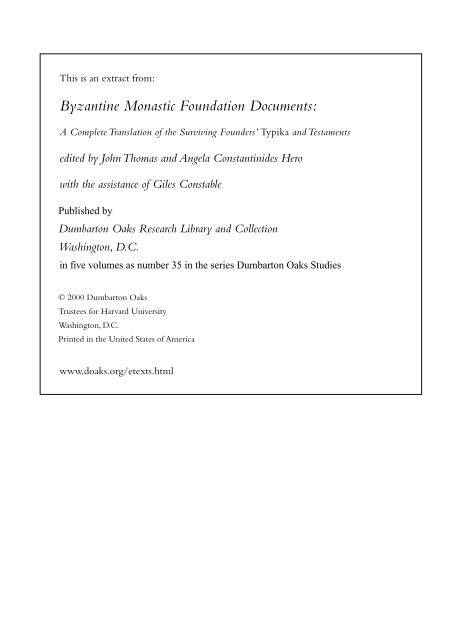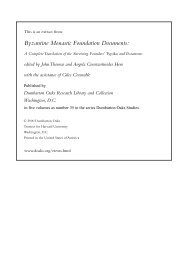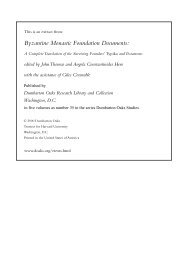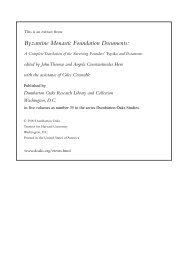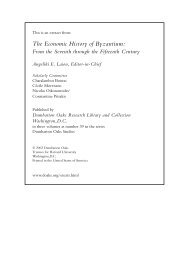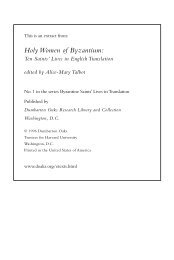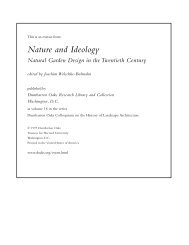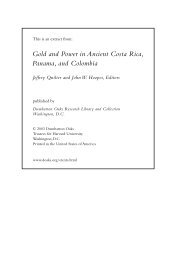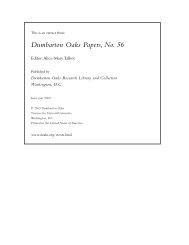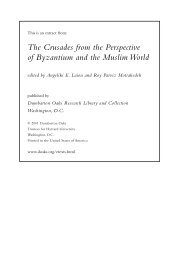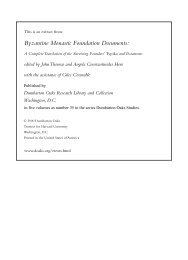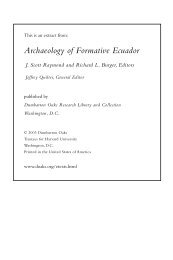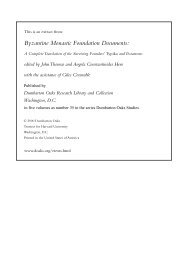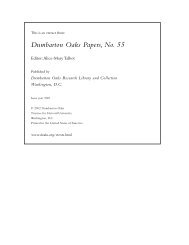47. Philanthropos - Dumbarton Oaks
47. Philanthropos - Dumbarton Oaks
47. Philanthropos - Dumbarton Oaks
Create successful ePaper yourself
Turn your PDF publications into a flip-book with our unique Google optimized e-Paper software.
This is an extract from:<br />
Byzantine Monastic Foundation Documents:<br />
A Complete Translation of the Surviving Founders’ Typika and Testaments<br />
edited by John Thomas and Angela Constantinides Hero<br />
with the assistance of Giles Constable<br />
Published by<br />
<strong>Dumbarton</strong> <strong>Oaks</strong> Research Library and Collection<br />
Washington, D.C.<br />
in five volumes as number 35 in the series <strong>Dumbarton</strong> <strong>Oaks</strong> Studies<br />
© 2000 <strong>Dumbarton</strong> <strong>Oaks</strong><br />
Trustees for Harvard University<br />
Washington, D.C.<br />
Printed in the United States of America<br />
www.doaks.org/etexts.html
<strong>47.</strong> PHILANTHROPOS<br />
<strong>47.</strong> <strong>Philanthropos</strong>: Typikon of Irene Choumnaina Palaiologina for<br />
the Convent of Christ <strong>Philanthropos</strong> in Constantinople<br />
Date: ca. 1307 1<br />
Translator: Alice-Mary Talbot<br />
Edition employed: Ph. Meyer, “Bruchstücke zweier typika ktetorika,” BZ 4 (1895), 45–58, with<br />
text at 48–49.<br />
Manuscript: Iveron codex 593 (1540 A.D.) 2<br />
Other translations: None<br />
Institutional History<br />
A. Foundation under the Choumnos Family<br />
Irene Choumnaina, the daughter of the influential courtier Nikephoros Choumnos, was the founder<br />
of this convent, to which she retired under the monastic name Eulogia after the death of her<br />
husband the despot John Palaiologos, eldest son of Andronikos II and Yolanda-Irene of Montferrat,<br />
in 1307. This foundation was built into the Theodosian sea walls in the extreme easternmost part<br />
of Constantinople, on the site of an earlier monastic complex about which nothing is known. For<br />
nearly fourteen years until his death in 1322, Eulogia’s spiritual advisor was Theoleptos, metropolitan<br />
of Philadelphia. Five of his letters to her on monastic subjects are preserved. These provide<br />
useful insights into Eulogia’s suitability for leadership and various disciplinary problems in<br />
the foundation. Some ten to fifteen years after Theoleptos’ death, Eulogia acquired another spiritual<br />
advisor, a young monk whose identity is unknown. An extensive correspondence between<br />
them has been edited by Angela Hero. 3<br />
There was a companion male monastery associated with the convent also bearing a dedication<br />
to Christ <strong>Philanthropos</strong>. At the conclusion of his career, Nikephoros Choumnos retired to this<br />
monastery under the monastic name Nathaniel. In his Testament, he leaves instructions for his<br />
burial there and claims that he and his wife were responsible for building it. 4 His wife, Eulogia’s<br />
mother, evidently retired at the same time to the convent under her daughter’s direction. Nikephoros<br />
died at the monastery in 1327, and his wife at the convent a little later. Eulogia herself died circa<br />
1355.<br />
B. Subsequent History and Fate of the Foundation 5<br />
The Russian pilgrim, deacon Zosima, reports the existence of the convent of <strong>Philanthropos</strong> ca.<br />
1420. Other Russian travelers of the fourteenth and fifteenth centuries point out a famous miracleworking<br />
image of Christ. There was also a miraculous, healing fountain located under the church<br />
which flowed into a cistern on the beach outside the sea walls and then out onto the sand. Majeska<br />
(Russian Travelers, pp. 373–74) reports that this fountain was visited by local Greek Christians<br />
[ 1383 ]
FOURTEENTH CENTURY<br />
down to the nineteenth century even though it was then on the grounds of the sultan’s palace, the<br />
construction of which surely led to the demolition of the rest of the Christian complex. Both the<br />
cistern and substructures of various monastic buildings still exist on the site. Excavations carried<br />
out by the French army of occupation in Constantinople in 1921–23 have made it possible to<br />
identify the foundations of the former church.<br />
Analysis<br />
This text owes its preservation to Pachomios Rhousanos, a monk of the Athonite monastery of<br />
Iveron, who in 1540 transcribed the surviving excerpt of this document along with that of (56)<br />
Kellibara II in support of his attack on the idiorhythmic monastic foundations that were popular in<br />
his own day. He was clearly looking for authoritative pro-cenobitic citations such as this document<br />
provides. His excerpts from (56) Kellibara II are concerned with related themes of monastic<br />
equality ultimately derived from the Evergetian monastic reform movement.<br />
A. Model Typikon<br />
The excerpt that makes up all that remains of this document here is a reworking of Empress Irene<br />
Doukaina Komnene’s (27) Kecharitomene [2]. 6 Since the Komnenian empress was also the founder<br />
of an identically named male monastery of Christ <strong>Philanthropos</strong> for which she presumably wrote<br />
a typikon analogous to (27) Kecharitomene, the document represented by this excerpt here may<br />
have been an adaptation (genders changed) of that institution’s lost typikon. 7 However, Janin<br />
thought that the Komnenian and the Palaiologan foundations were entirely different foundations,<br />
located in different areas of Constantinople. 8<br />
In any event, this document is a valuable example of the utilization and elaboration by an<br />
author in Palaiologan times of a much older document in the Evergetian tradition. Even if there<br />
was in fact no institutional link between the Komnenian and Palaiologan monasteries of the Philanthropic<br />
Savior, there is other evidence of a renewed popularity of the Evergetian monastic usages<br />
in the late thirteenth and early fourteenth centuries. As we have seen, (37) Auxentios shares<br />
certain usages and even a few similarities of diction with (22) Evergetis. Like (47) <strong>Philanthropos</strong>,<br />
(58) Menoikeion appears to copy another document in the later Evergetian tradition, specifically<br />
(32) Mamas. Moreover, (39) Lips and (56) Kellibara II both suggest an acquaintance with Evergetian<br />
models, (27) Kecharitomene and (22) Evergetis respectively.<br />
B. Lives of the Nuns<br />
The author’s enthusiastic endorsement [1] of cenobitic life, while actually traceable to (27)<br />
Kecharitomene [2], is credited both to “the holy and inspired fathers of old” and contemporary<br />
authorities, namely bishops, ascetics, monks and nuns, presumably including (so Trone, “Philanthropic<br />
Savior,” p. 84) the author’s own spiritual mentor Theoleptos, metropolitan of Philadelphia<br />
(✝ ca. 1322) and Patriarch Athanasios I (1289–1293, 1303–1309), author of (55) Athanasios I. The<br />
essentials of the cenobitic life [2] were the common refectory, kitchen, and manual labor. Nuns<br />
were expected to devote the “appropriate amount of attention” to the communal activities of handiwork,<br />
ecclesiastical services, housekeeping duties, and reading and prayer in their cells. This<br />
suggests a common participation in these activities rather than the specialization by particular<br />
[ 1384 ]
<strong>47.</strong> PHILANTHROPOS<br />
classes of nuns that was featured at other contemporary institutions, e.g., (39) Lips [4]. A nun<br />
caught practicing private crafts or cooking food in her cell was to be disciplined “no matter who<br />
she is” (i.e., regardless of social standing) and expelled if unrepentant.<br />
The author singles out [2] for condemnation nuns having an entrepreneurial approach to their<br />
work. As in (27) Kecharitomene [2], the convent’s cenobitic constitution was not to change [3]<br />
regardless of whether the foundation became richer or poorer in the future. Her adoption of her<br />
model’s prescription [4] that the superior should oppose the nuns or vice versa should any constitutional<br />
change away from cenobiticism be proposed omits the oversight roles provided for in<br />
(27) Kecharitomene [2] for the protectress and the founder’s relatives. At the end of his excerpt,<br />
Pachomios Rhousanos appends a note that suggests that the lost text of our document continued at<br />
length in a similar vein, emphasizing the virtues of monastic poverty. 9<br />
Notes on the Introduction<br />
1. See Hero, “Irene-Eulogia” (1981), p. 5.<br />
2. See Meyer, “Bruchstücke,” p. 50.<br />
3. Hero, Woman’s Quest, pp. 26–100, with English translation, pp. 27–101.<br />
4. Nikephoros Choumnos, Testamentum, PG 140, cols. 1465–98, esp. 1481.<br />
5. See Janin, Géographie, vol. 3, p. 528, and Majeska, Russian Travelers, pp. 371–74.<br />
6. First noticed by Salaville, “Formes,” p. 46.<br />
7. For pronoun gender changes, see Trone, “Philanthropic Savior,” p. 84.<br />
8. Janin, Géographie, vol. 3, pp. 527–29, cf. 525–27.<br />
9. The note may refer to a lost chapter of (47) <strong>Philanthropos</strong> based on (27) Kecharitomene [50], though that<br />
particular chapter is not in fact very long. It is also possible that Pachomios’ reference is to other lost<br />
chapters in (47) <strong>Philanthropos</strong> and/or (56) Kellibara II that were independent of those extant in the<br />
known models for these respective documents.<br />
Bibliography<br />
Beck, Hans-Georg, Kirche und theologische Literatur im byzantinischen Reich (Munich, 1959), p. 6<strong>47.</strong><br />
Demangel, Robert, and Mamboury, E., Le quartier des Manganes et la première region de Constantinople<br />
(Paris, 1939), pp. 49–68.<br />
Gedeon, Manuel, Byzantinon Heortologion (Constantinople, 1899), p. 204.<br />
Gouillard, Jean, “Après le schisme arsénite. La correspondance du Pseudo-Jean Chilas,” Académie roumaine.<br />
Bulletin de la section historique 24 (1944), 174–211.<br />
Hatzidakis, G. N., and Kurtz, Ed., “Zu den Bruchstücken zweier Typika,” BZ 4 (1895), 583–84.<br />
Hero, Angela, “Irene-Eulogia Choumnaina Palaiologina, Abbess of the Convent of <strong>Philanthropos</strong> Soter in<br />
Constantinople,” BF 9 (1985), 119–<strong>47.</strong><br />
———, A Woman’s Quest for Spiritual Guidance: The Correspondence of Princess Irene Eulogia Choumnaina<br />
Palaiologina (Brookline, Mass., 1986).<br />
———, “Theoleptos of Philadelphia (ca. 1250–1322): From Solitary to Activist,” in Twilight of Byzantium:<br />
Aspects of Cultural and Religious History in the Late Byzantine Empire, ed. Slobodan Çurciç and<br />
Doula Mouriki (Princeton, 1991), pp. 27–38.<br />
———, “The Life and Letters of Theoleptos of Philadelphia (Brookline, Mass., 1994).<br />
Janin, Raymond, La géographie ecclésiastique de l’empire byzantin, vol. 3: Les églises et les monastères<br />
[de Constantinople], 2nd ed. (Paris, 1969), pp. 527–29.<br />
———, “Les monastères du Christ Philanthrope à Constantinople,” EB 4 (1946), 135–62.<br />
[ 1385 ]
FOURTEENTH CENTURY<br />
Laurent, V., “La direction spirituelle à Byzance: La correspondance d’Irène-Eulogie Choumnaina Paléologine<br />
avec son second directeur,” REB 14 (1956), 48–86.<br />
———, “Une fondation monastique de Nicéphore Choumnos,” REB 12 (1954), 32–44.<br />
———, “Une princesse byzantine au cloître. Irène-Eulogie Choumnos Paléologine, fondatrice du couvent<br />
des femmes tou Philanthropou Soteros,” EO 29 (1930), 29–60.<br />
Majeska, George, Russian Travelers to Constantinople in the Fourteenth and Fifteenth Centuries (Washington,<br />
D.C., 1984), pp. 371–74.<br />
———, “The Sanctification of the First Region: Urban Reorientation in Palaeologan Constantinople,” Actes<br />
du XV e Congrès international d’Études byzantines, Athènes, 1976, vol. 2 (Athens, 1981), 359–65, esp.<br />
361–64.<br />
Mathews, Thomas, The Byzantine Churches of Istanbul: A Photographic Survey (University Park, Pa., 1976),<br />
pp. 200–204.<br />
Medico, M. H. E. del, “Essai sur Kahrié Djami au début du XII e siècle,” BZ 32 (1932), 16–48.<br />
Müller-Wiener, Wolfgang, Bildlexikon zur Topographie Istanbuls (Tübingen, 1977), p. 109.<br />
Pargoire, Jules, “Les monastères doubles chez les Byzantins,” EO 9 (1906), 21–25.<br />
Salaville, S., “Un directeur spirituel à Byzance au début du XIV e siècle: Théolepte de Philadelphie,” in<br />
Mélanges Joseph de Ghellinck, S.J., vol. 2 (Gembloux, 1951), pp. 877–87.<br />
———, “Formes ou méthodes de prière d’après un byzantin du XIVe siècle, Théolepte de Philadelphie,”<br />
EO 39 (1940), 1–25.<br />
———, “Une lettre et un discours inédits de Théolepte de Philadelphie,” REB 5 (1947), 101–15.<br />
———, “La vie monastique grecque au début du XIV e siècle d’après un discours inédit de Théolepte de<br />
Philadelphie,” EB 2 (1944), 119–25.<br />
Sevcenko, Nancy, “Choumnos, Nikephoros,” ODB, pp. 433–34.<br />
Sidéridès, Xenophon, “Peri tes en Konstantinoupolei mones tou Soteros tou Philanthropou,” EA 17 (1897),<br />
234–36, 250–51, 257–59, 267–68, 276–79, 291–93, 309–10, 316–19, 323–25, 341–43; EA 18 (1898),<br />
4–6, 10–11.<br />
Talbot, Alice-Mary, “Choumnaina, Irene,” ODB, pp. 432–33.<br />
Trone, Robert, “A Constantinopolitan Double Monastery of the Fourteenth Century: The Philanthropic Savior,”<br />
BS/EB 10 (1983), 81–87.<br />
Verpeaux, J., Nicéphore Choumnos, homme d’état et humaniste byzantin (ca. 1250/1255–1327) (Paris, 1959).<br />
———, “Notes prosopographiques sur la famille Choumnos,” Byzantinoslavica 20 (1959), 252–66, esp.<br />
260–61.<br />
Key: As noted above, the author of this typikon utilizes a portion of (27) Kecharitomene. In our<br />
translation, the borrowings are indicated in boldface type.<br />
Translation<br />
[An excerpt] from the typikon of the venerable monastery of Christ the Philanthropic Savior,<br />
restored from its foundations by the pious princess Irene Laskarina Palaiologina, who took the<br />
name Eulogia after adopting the divine and angelic habit, and by her parents, 1 [the said typikon]<br />
having been expounded and issued by her.<br />
[1.] [cf. (27) Kecharitomene [2], ed. lines 218–23]: I think it would be right that something be<br />
said more clearly and briefly next concerning the way of life of the nuns and the whole<br />
[ 1386 ]
<strong>47.</strong> PHILANTHROPOS<br />
organization of life in the convent. For what will be prescribed on this matter will be compatible<br />
with what has been clearly stated and declared by the holy and inspired fathers of old, the<br />
present holy bishops and the most experienced ascetics and monks, as well as elderly nuns, who<br />
over a long period of time have assembled exact and true experience of asceticism. For they<br />
decided and laid it down that those who have renounced the world and worldly things and took<br />
refuge in the calm harbor of monastic life in accordance with God, that they should follow a<br />
cenobitic way of life and give themselves up to [a life of] submission, renouncing their own<br />
will, which the fathers termed “mortification.”<br />
[2.] [cf. (27) Kecharitomene [2], ed. lines 226–29]: Therefore obeying these [authorities], I<br />
very much wish and desire that the nuns in the convent of my Philanthropic Savior should live<br />
in a cenobitic order and way of life and not only should they all have a common refectory, but<br />
also a common kitchen and the same handiwork. For thus [the nuns] would devote the appropriate<br />
amount of attention [to all their] common [activities], their handiwork, church services, all the<br />
[housekeeping] duties, reading [p. 49] and prayer in their cells, and all other spiritual labor, since<br />
thereby they behave like nuns and not like businesswomen and even worse than laymen. If one of<br />
the nuns should be caught doing her own private handiwork, or preparing food in her private cell,<br />
she should be severely censured and disciplined, and banished from the church and the refectory<br />
until she mends her ways, no matter who she is. If she should disobey and act insolently and not be<br />
willing to mend her ways, she is to be expelled from the convent. For a few women gathered in the<br />
name of the Lord are far superior to many who reject a life in accordance with God and the<br />
monastic and ascetic mode of conduct. 2<br />
[3.] [ = (27) Kecharitomene [2], ed. lines 229–39]: Thus my majesty wishes that the rule of such<br />
a cenobitic system should always be in force in it, unchanged and unaltered and unshaken by<br />
every misfortune, perverted or changed in no way during the existence of this whole age, nor<br />
altered for any reason or pretext whatsoever, neither because of wealth or poverty, neither<br />
through scarcity or abundance, nor any other plausible reason or pretext whatsoever, but<br />
the cenobitic order and way of life should be completely preserved in every way unbroken<br />
for ever. Even if the entire income of the convent should happen to be reduced to what would<br />
be enough for two nuns, we wish them to live in the cenobitic way and conform to the rule for<br />
this way of life.<br />
[4.] [ = (27) Kecharitomene [2], ed. lines 239–48]: If a future superior wants to countermand<br />
this, the nuns have permission to speak against it, and if the nuns should attempt the opposite,<br />
she has permission to overrule them. But if she and the nuns should both be led astray, we<br />
grant permission to anyone who wishes to fight for a holy object to go to court for goodness<br />
itself and the reward for this, to seek that what we have laid down should be effective and<br />
that those chiefly responsible for the dissolution of the cenobitic way of life be expelled from<br />
the convent and not consider this a small achievement but one that is very great and brings<br />
salvation.<br />
[ 1387 ]
FOURTEENTH CENTURY<br />
[Scribal note:] The typika 3 of the pious rulers also had other chapters on poverty, but I omitted<br />
them because of their length.<br />
Notes on the Translation<br />
1. Nikephoros Choumnos and Choumnaina; see Verpeaux, “La famille Choumnos,” pp. 254–57.<br />
2. Cf. the language of (22) Evergetis [23].<br />
3. (47) <strong>Philanthropos</strong> and (56) Kellibara II.<br />
Document Notes<br />
[1] Sources of authority for the cenobitic life. Shared in part with (27) Kecharitomene [2], (32) Mamas [5],<br />
and (33) Heliou Bomon [5].<br />
[2] Common refectory, kitchen, and handiwork; practice of reading and prayer in the cells but no private<br />
handiwork or cooking. Shared in part with (27) Kecharitomene [2].<br />
[3] Inalterability of the cenobitic life. Shared with (27) Kecharitomene [2].<br />
[4] Superior and nuns may prevent one another from instituting changes; outsiders may bring suit to prevent<br />
abandonment of cenobiticism. Shared with (27) Kecharitomene [2].<br />
[ 1388 ]


